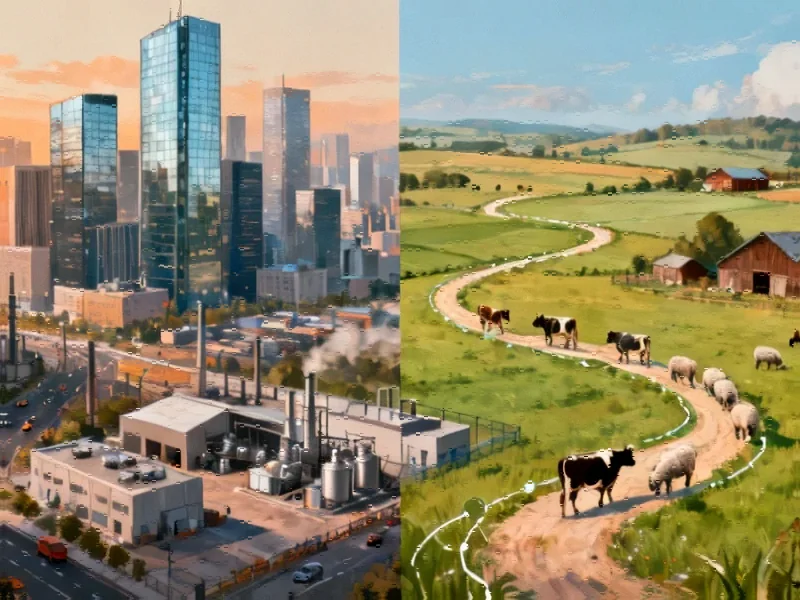Revealing the Hidden Environmental Costs of Urban Meat Consumption
A groundbreaking study published in Nature Climate Change has developed an innovative methodology to trace the complete environmental footprint of urban meat consumption back through complex supply chains to rural production areas. The research demonstrates how urban and rural communities are inextricably linked through meat consumption patterns, creating what researchers term “carbon hoofprints” that extend far beyond city boundaries.
The study represents a significant advancement in understanding how dietary choices in metropolitan areas create environmental impacts across geographical regions. By mapping these connections, the research provides policymakers with crucial data to develop more effective sustainability strategies that acknowledge the interconnected nature of modern food systems.
Methodology: Tracing Meat from Plate to Production
Researchers expanded the Food Systems Model (FoodS) to analyze 3,531 U.S. cities, creating what amounts to one of the most comprehensive analyses of urban food systems ever conducted. The model tracks tens of thousands of supply chains connecting animal feed production, livestock operations, and processing facilities to final consumption points in urban areas.
The team utilized data from the National Health and Nutrition Examination Survey (NHANES), combining five iterations of the survey to create a robust sample of 51,623 individuals. This approach allowed researchers to account for demographic variations in meat consumption patterns while maintaining statistical reliability. The methodology represents significant progress in data integration techniques that could influence how we analyze complex systems across multiple sectors.
Demographic Patterns in Meat Consumption
The research revealed distinct consumption patterns based on race, ethnicity, and income levels. By creating eight unique consumption profiles for each meat type, researchers could more accurately estimate demand at the county level. High-income households (those earning 200% above poverty levels) showed statistically significant differences in meat consumption compared to lower-income groups.
These demographic insights are crucial for understanding how socioeconomic factors influence environmental impacts through consumption choices. The findings highlight the need for tailored approaches to sustainable food systems that consider these demographic variations rather than treating urban populations as homogeneous.
Supply Chain Modeling and Environmental Accounting
The expanded FoodS model represents a major advancement in supply chain transparency. By connecting crop production to livestock operations and finally to meat processing and distribution, the model creates a complete environmental accounting system. This approach includes spatial modeling of transportation networks, life-cycle assessment of environmental impacts, and optimization of distribution patterns.
The complexity of modern supply chains requires sophisticated modeling approaches, similar to those needed to understand other critical infrastructure systems. Recent industry developments in cloud computing infrastructure demonstrate how single points of failure can have cascading effects, much like the environmental impacts revealed in this meat supply chain research.
Implications for Urban Sustainability Planning
This research fundamentally challenges conventional approaches to urban sustainability that focus primarily on emissions generated within city boundaries. By demonstrating how urban consumption drives rural environmental impacts, the study argues for a more holistic approach to sustainability planning that acknowledges these cross-boundary relationships.
The findings come at a critical time when cities worldwide are developing climate action plans. As documented in a related study on urban carbon mapping, understanding these consumption-based emissions is essential for creating effective decarbonization strategies.
Broader Industrial and Technological Context
The methodologies developed in this research have implications beyond food systems analysis. The data integration and modeling approaches could be applied to other sectors where consumption patterns drive environmental impacts across regions. As we’ve seen with recent technology innovations in emulation software, advanced modeling techniques are becoming increasingly important across multiple industries.
Similarly, the supply chain transparency achieved in this study aligns with broader trends in industrial accountability and environmental reporting. Companies across sectors are facing increasing pressure to account for Scope 3 emissions throughout their value chains, much like the comprehensive accounting demonstrated in this meat supply chain research.
Future Research Directions and Applications
The study acknowledges several limitations that point toward future research opportunities. The NHANES data, while comprehensive, suffers from systematic under-reporting of meat consumption and doesn’t capture regional culinary variations. Future work could incorporate additional data sources, such as supermarket scanner data, to address these limitations.
The research framework could also be expanded to include other environmental impacts beyond carbon emissions, such as water usage, land use change, and biodiversity impacts. As seen in related innovations in browser technology, continuous improvement and expansion of analytical capabilities are essential for addressing complex environmental challenges.
Policy Implications and Implementation Challenges
The findings present both opportunities and challenges for policymakers. While the research provides crucial data for developing more effective sustainability strategies, implementing changes across complex, interconnected supply chains requires careful coordination between urban and rural stakeholders.
Recent market trends in industrial supply chain management demonstrate how companies are reevaluating their geographical footprints and distribution networks, creating potential synergies with the type of supply chain optimization suggested by this research.
Technological Infrastructure and System Resilience
The sophisticated modeling required for this research highlights the importance of robust computational infrastructure and data management systems. As we’ve seen with recent updates to media server technology, maintaining and improving complex systems requires continuous investment and development.
Similarly, the interconnected nature of modern supply chains means that disruptions can have far-reaching consequences, much like the cascading effects observed in cloud computing failures. Understanding these vulnerabilities is crucial for building more resilient food systems.
Conclusion: Toward Integrated Sustainability Solutions
This research represents a paradigm shift in how we conceptualize urban sustainability. By making the connections between urban consumption and rural production visible, the study provides the foundation for more integrated approaches to environmental management. The carbon hoofprint concept challenges cities to look beyond their geographical boundaries and acknowledge their role in driving environmental impacts throughout supply chains.
As cities continue to grow and consumption patterns evolve, this type of comprehensive environmental accounting will become increasingly important for developing effective sustainability strategies that address the full scope of urban environmental impacts.
This article aggregates information from publicly available sources. All trademarks and copyrights belong to their respective owners.
Note: Featured image is for illustrative purposes only and does not represent any specific product, service, or entity mentioned in this article.



